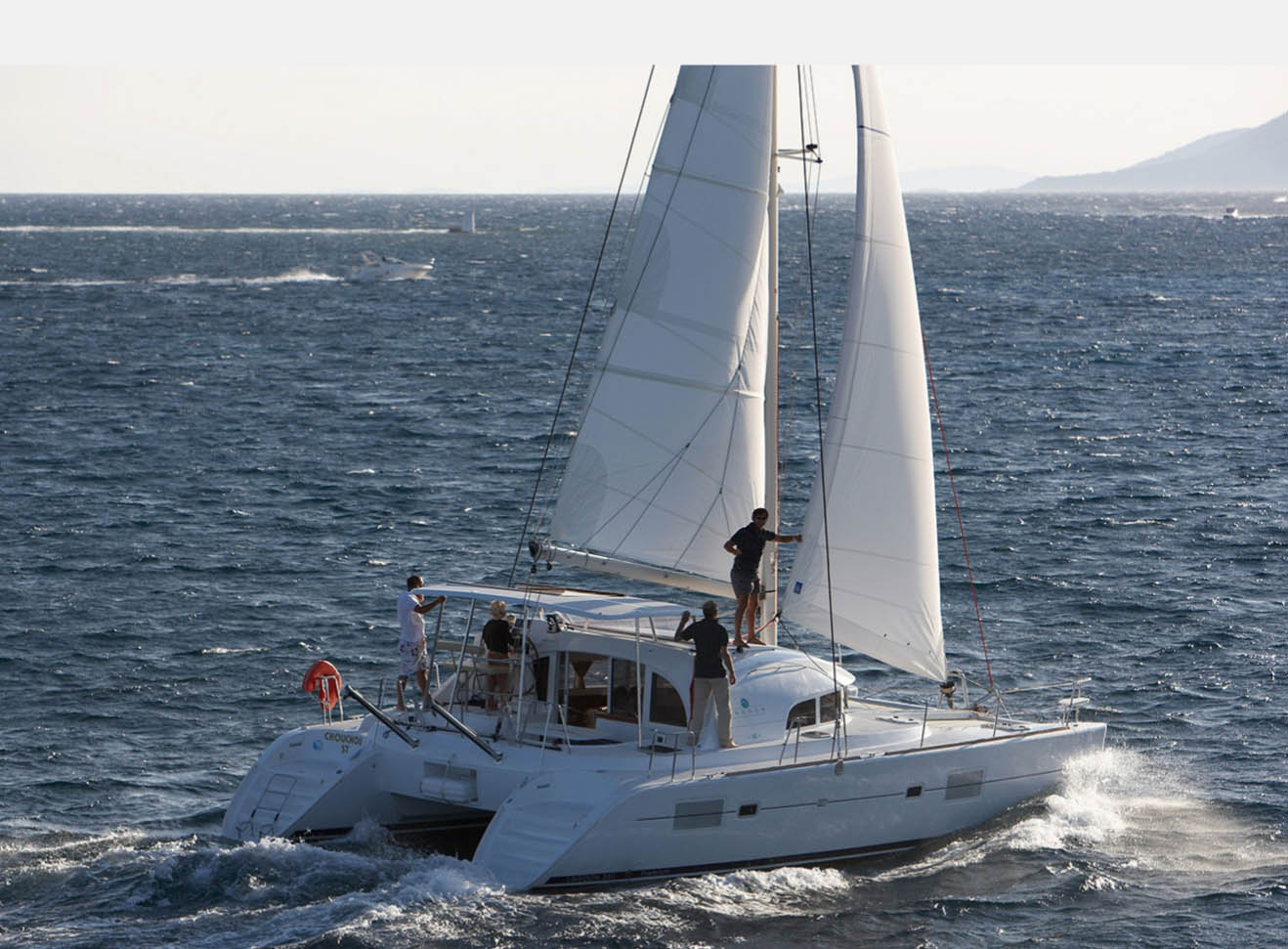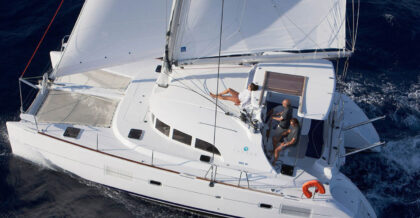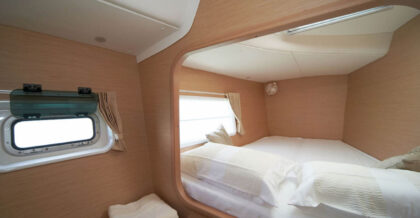Lagoon 380
Until recently, when is was overtaken by the 42, the Lagoon 380 was the best selling catamaran in the world. Ever. You just can’t knock ’em can you? They were launched after the 410 and you can see the family resemblance.

Production Numbers in 4 Figures
Lagoon delivered over 1000 boats over the production lifetime. Line her up against the Lagoon 46 catamaran and she still comes out as the top seller although production has now ceased. The 42 overtook her in 2024.
The entry level boat at Lagoon is now the Lagoon 40, although sister company Excess has a 37 footer on its books: the Excess 11. Lagoon has also announced a new 38 that will luanch in 2025.
more…
Circumnavigator
The Lagoon 380 is a proven ocean crosser. She’s a sturdy, safe little boat that saw off the Lagoon 39 (also no longer in production) and continues to attract fans. She holds her value pretty well on the 2nd hand market too – quite a feat when you think of how many 380s are out there.
A Classic Catamaran
This is an economical boat that is comfortable and has an acceptable level of performance. She’s no Ferrari (read our Gunboat 68 review if that is more your budget). I would say she’s more of a Renault Espace. A reliable, solidly built catamaran that’s roomy for her size. How many other boats have this many hull numbers under their belt to feed back into the design process?
I can only think of the Prout Snowgoose. The L450 comes close. And the Lagoon 42 of course.
Lagoon’s signature vertical windows mean that you get the maximum space possible inside the boat for her length.
Open up the double sliding doors and you have a decent sized area up top and the forward windows open right up to let the breeze flow through the boat at anchor.
Acceptable Performance
You can expect to sail at 6 to 9 knots in a decent breeze – perfectly acceptable for cruising. She won’t sail to windward like a dagger-board cat, but what were you expecting?
You’ll probably be pointing at 55-60 degrees to true and doing 6 knots or so. Stick the leeward engine to get the speed up and head 10-15° or so higher.
read more…
Bear Away
Off the wind, she’s a great little mover! You will see the low teens in decent conditions from time to time.
She does have a reputation for being a bit of a hobby horse when the waves get up, but we are talking a 38 foot boat, right? You might need to focus on getting weight off the nose and away from the stern for longer passages: try to centralise the weight as much as you can. All in all though, she’s a compact, cosy boat.
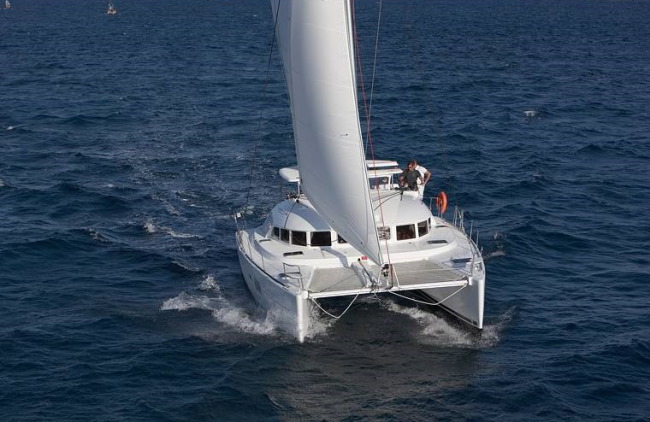
The design of the Lagoon 380 has been well thought out and hits the sweet spot for this length of boat. Well, some would argue that Group Beneteau’s newer Excess 11 Catamaran takes that prize, but the 380 has the sales to back it up.
Good Clearance
Bridgedeck clearance is good and the sail plan will happily cover you from anything from 9 knots of wind to 35. You should be averaging 7 knots SOG most of the time giving you 150 nm a day- perfectly acceptable for safe long distance cruising.
The other thing is that it is difficult to see and trim the mainsail on a starboard tack given that the helm is on the port bulkhead. But this is not an issue that is unique to the 380.
Well Organised
The running rigging is well thought out for short handed sailing. With an electric winch for the main halyard, she’s easy to handle on your own and Lagoon have over spec’d the standing rigging on this boat. She´s a safe little mover.

Windward performance isn’t what we would call stellar – but that’s your trade off for such as comfortable boat for this size. You can always stick the leeward engine on or plan your sailing well! The square headed mainsail option on later boats is definitely one to look out for.
You Won’t Overtake a Gunboat Upwind
At 55 to true, she will sail. At 45-50 degrees, the speed drops off and you will be pushed sideways.
In light to moderate winds when close hauled, set the traveler to windward a couple of feet from centre & ease the main sheet a bit. Keep the momentum up before a tack and move the boat through the wind cleanly and steadily and she won´t stall.
At the end of the day, you´ll need dagger-boards to sail well to windward and that means less space and comfort. An older Catana would probably do it. The speed will drop off if you are sitting at 50 degrees or less to apparent, and in anything under 10 knots of wind you will need the engines on unless you have a bowsprit fitted and a Code 0 or gennaker to fly.
Put the first reef in at around 18 knots depending on your angle of sail & second reef when it blows over 25.
The 380 does hobby horse, so make sure that you move the weight back on longer passages (including the main anchor, for example). In a moderate to rough sea you may notice some slamming, especially going into the weather, but no more than comparable sized cats.
The 380 is not the lightest boat for her size- it is a production boat after all, but it does pack a decent sail plan with an SA/D ratio of 22 (square top mainsail option) which is higher than many of Lagoon’s current models.
The hull is solid fiberglass below the waterline and is cored with a mix of foam and balsa above the waterline. Lagoon use a vinlyester resin in the outer layers of the laminate to protect against blistering. The deck is balsa-cored with solid laminate under the areas that need more strength.
Interior bulkheads are bonded to the outer sides of the hulls.
Interiors

The design of the interior is excellent and makes the most of the available space. With dual sliding doors that open up the saloon into the aft cockpit, vertical windows to maximise the space (and minimise the heat in the sun), a galley up top, safe seating for 6 in the cockpit and a helm position with good visibility that is connected to the living area of the boat.
Cosy with Guests
The saloon table and seating area is really cosy- great for entertaining, and you have a nav station, fridge and galley all in here. Pretty impressive!
The cabins are spacious for a 38 footer and the heads are functional.
The finish is not the highest quality, but it is acceptable at this price point and easy to fix. They are known to look tired quickly as the veneer damages easily, so you will need to look after her. The other big downside is the soft top bimini on older versions: you´ll just have to live with it at this price point, or dust off your wallet and add a hard top bimini and dodger.
The Hard Top Bimini Came Later
Later versions have the hard top bimini as standard, with a neat sliding sunroof to poke your head out of. The mainsheet traveller remained on the aft beam.
Lagoon 380 S2
This being a yacht with such a long production run (1999 to 2019), the Lagoon 380 molds went through a few modifications. For example, Hull #35 (Serenity Now) was built in 2000, still almost 1000 hulls off the final production run tally. Barit is hull number 509, launched 2008.
The main upgrade (although owners of the original design would probably say it was a downgrade) was with the launch of the Lagoon 380 S2 in 2003.
The main changes they made were:
- New shelves over the engine compartments
- They moved the bulkhead of the shower forward in the Starboard Hull (more space inside, less in the forward locker).
- Larger windows in the hulls
- Sliding door for privacy in the owner’s hull (on the owner’s version of course)
- Improved galley, sink and countertop
- Improved helm dash (on later S2s)
- Double helm seat (a good addition this)
- Additional winch on the port side.
The Twin Volvos 30s (well 29s) are more than enough to power you through the chop. Cruising speed with one engine is around 5 and a half knots, using around 2.5 litres per hour. Stick the other engine on and you will hit 7 knots comfortably, with 8 knots at Full Steam Ahead.
Very Manoeuvrable
And with twin engines manoeuvering a relatively small cat, you’ll start to feel like you are an old hand in the marina in no time.
The engine rooms are well deigned as well, and easy to access.


Because the 380 is such a popular boat, there are quite a few good sailing blogs out there which are useful if you want to get a better feel for the catamaran.
From the Horse’s Mouth
A good one is Sailing on the Sunnyside which all about a couple living the minimalist life on their 380: Sunnyside. She´s hull number 322, made in 2005.
You should also check out the blog archive of Seth from the Sailing Family. They circumnavigated on a Lagoon 380 called Honeymoon: that is worth a read.
They have now upgraded to an Outremer 51 (well, you would if you could, wouldn’t you?)
SV Straycat is another 380 blog on a 2000 Lagoon (hull # 24). There’s a great description of the boat on the blog.
Then there’s the Phase 2 Catamaran vlog. These guys are really out there enjoying themselves.
Lagoon 380 Plan
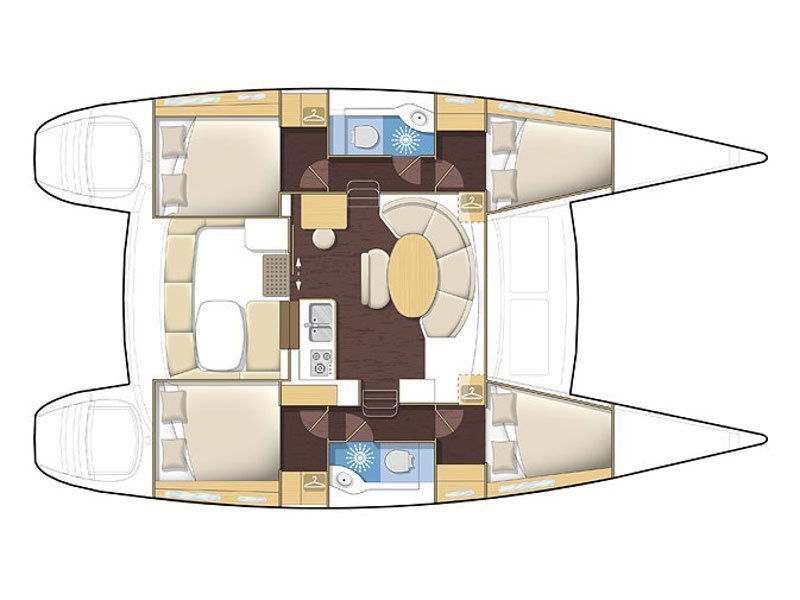

Download the Lagoon 380 brochure from the link below.
Summary
The stand out fact about the Lagoon 380 is that they have sold so many. You get what you pay for, of course, and with the 380 you get a lot for your money. Lagoon deliver exactly what they promise.
These catamarans are great value for money and are easily able to stand up to regular private use, but make sure you keep on top of that ‘job list’. But that´s the same for any boat, right?
It’s a Clever Design
The Lagoon 380 is a clever compromise on volume versus performance, and she has a very good load-carrying capacity for a boat that is less than 40 feet.
She’s a classic catamaran.
FAQs
Is the Lagoon 380 still in Production?
No, Lagoon stopped making the 380 in 2019. Originally, it was going to be replaced by the 39, but they stopped production on that boat as well. The smallest Lagoon cat is now the 40. You might want to check out the Excess 11 which is part of the same Group – it’s a similar sized boat, but has aft helms.
How many 380s did Lagoon produce?
They made around 1000. It is one of their top selling models behind the 42.
How much does a Lagoon 380 cost?
There are plenty on the second hand market, but good examples hold their price and they remain popular. You can pick one up from €120,000 to €200,000 on the second hand market, we´d say you need to spend from 150-180k for a decent, well looked after boat. There are a lot of ex charter boats out there on the market – that’s fine, but they might need some money spent on them.
What are the Main Differences Between a Lagoon 380 and a Lagoon 380 S2?
The shower bulkhead was moved forward in the S2 to create a bigger shower/head. Larger windows were used in the hulls and a sliding privacy door was installed in the owner’s hull. They improved the galley and remolded the helm station. These were all minor changes, more of a marketing update if anything, and many prospective buyers prefer the older boats which have more storage, better quality interior finishes and easier access to the engines. The first 380 S2 launched in 2003.
| Length Overall | 11.55m / 37´ 11″ |
|---|---|
| Length at Waterline | 11.00 m / 36.08′ |
| Beam Overall | 6.53m / 21´ 5″ |
| Draft | 1.15m / 3´9″ |
| Disp. (Light) | 7.3 tonnes / 16,094 lbs |
| D/L | 132 |
| Mainsail | 47/52* m² / 506/560* sq ft |
| SA/D | 21 / 22* |
| Water | 300 l / 79 US gal |
| Genoa | 30m² / 323 sq ft |
| Engines | 2 x 18, 21 or 28 HP |
| Diesel | 2 x 100 litres / 2 x 26 US gal |
| SA/D* | 21 / 22* |
Contact Katamarans
Share your details with us and we’ll be in touch to discuss further.
"*" indicates required fields






